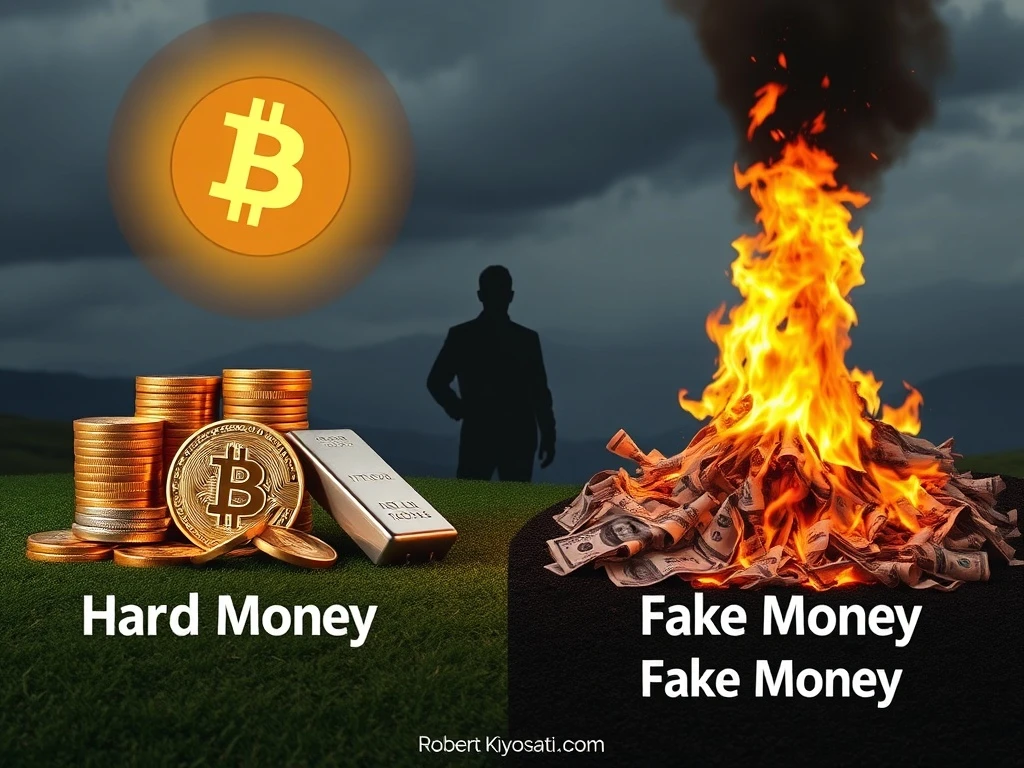Bitcoin: Robert Kiyosaki Declares ‘Fake Money’ a **Dangerous** Trap for Kids

Author Robert Kiyosaki, known for his bestselling book ‘Rich Dad Poor Dad,’ issues a stark warning. He claims children are being ‘brainwashed’ to work for what he calls ‘fake money.’ This provocative statement has captured the attention of many in the financial world, especially those interested in cryptocurrencies. Kiyosaki, a vocal proponent of **Bitcoin**, gold, silver, and oil, considers these assets ‘hard money.’ He argues they offer true protection against an inflationary system.
Robert Kiyosaki’s Critique: The “Fake Money” Trap
Robert Kiyosaki consistently challenges traditional financial wisdom. He argues that the academic system indoctrinates young people to pursue careers that ultimately lead them to work for ‘fake money.’ Furthermore, he asserts that this system perpetuates a cycle of financial vulnerability. Kiyosaki famously summarizes this indoctrination: “Go to school, get a job, work hard, save money, and invest in a 401(k) full of garbage.” This sentiment highlights his deep distrust of conventional financial planning.
During a podcast hosted by Bitcoin Collective Co-Founder Jordan Walker, Kiyosaki emphasized his concerns. He believes it is “criminal” to teach children to chase an inflationary currency. Instead, he advocates for understanding the nature of real wealth. Kiyosaki’s perspective often resonates with those seeking alternative investment strategies and a deeper understanding of economic principles.
Central Banks and the Erosion of Purchasing Power
Kiyosaki pulls no punches when discussing central banks. He equates them to “criminal organizations” and even labels them “Marxists.” His argument is straightforward: every time central banks print more money, they inadvertently enrich the already wealthy. Consequently, the poor and middle classes suffer significant economic setbacks. This creates a widening wealth gap.
Historical data supports some of Kiyosaki’s claims regarding inflation. For instance, the US Bureau of Labor Statistics’ headline inflation calculator shows a dramatic loss of purchasing power. A person holding $1,000 from August 2000 to August 2005 saw nearly 47% of their money’s value vanish. While the Federal Reserve targets 2% annual inflation, it has struggled to meet this goal since 2021. August’s headline inflation reached 2.9%, with core inflation at 3.2%. These figures underscore the challenge of maintaining wealth in an inflationary environment, highlighting the need for an effective inflation hedge.
Bitcoin: A Beacon of Hard Money
Kiyosaki strongly advocates for accumulating assets like gold, silver, oil, and especially **Bitcoin** and Ether. He labels these as ‘hard money’ because they resist the inflationary pressures of fiat currency. He sees them as essential tools for wealth preservation. The performance of Bitcoin, in particular, offers a compelling counter-narrative to traditional assets. Over the past five years, BTC has rallied more than 900%. It soared from approximately $11,670 to around $117,200 at the time of writing, according to CoinGecko. This remarkable growth showcases its potential as a robust hard money asset.
Kiyosaki openly shares his personal journey with Bitcoin. He admits it took him time to grasp its value. However, he started buying BTC at the $6,000 mark. Today, he holds about 60 **Bitcoin**, currently valued at approximately $7 million. He often expresses regret for not buying more, jokingly saying, “Why didn’t you buy more, asshole?” This personal anecdote underscores his conviction in Bitcoin’s long-term value.
Kiyosaki’s Investment Strategy and Future Predictions
Today, Kiyosaki strategically uses proceeds from his rental properties to acquire more oil, gold, silver, **Bitcoin**, and Ethereum. He maintains a bullish outlook on Bitcoin’s future. In April, he predicted that Bitcoin could reach the impressive $1 million milestone within the next decade. However, Kiyosaki has also offered a contrarian view, suggesting that even gold, silver, and Bitcoin might experience busts. He plans to accumulate more of these assets during such downturns.
Furthermore, Kiyosaki advises caution regarding Exchange Traded Funds (ETFs). He labels them “paper assets,” vulnerable to bank runs. Despite this warning, he acknowledges that ETFs offer the easiest entry point for retail investors into various asset classes. This balanced perspective highlights the complexities of modern investment.
Global Inflation and the Rise of Digital Assets as an Inflation Hedge
Kiyosaki’s claims about inflation hold significant merit globally. Hyperinflation, in particular, devastates the purchasing power of ordinary citizens. Consequently, people in nations experiencing severe inflation increasingly turn to cryptocurrencies. They view these digital assets as a critical financial shield. This trend demonstrates a growing global recognition of crypto’s role as an inflation hedge.
For instance, Venezuela offers a stark example. Its annual inflation rate touched 229%, leading many citizens to adopt stablecoins like Tether (USDT) for daily transactions. The Venezuelan Bolívar has significantly devalued; one US dollar traded for 51.95 Bolívar at the start of the year, but now buys 161.74 Bolívar. Meanwhile, Saifedean Ammous, author of ‘The Bitcoin Standard,’ predicts investors will flock to the US dollar and **Bitcoin** as the Argentine peso devalues. Real Vision CEO Raoul Pal also encourages investors to hold more crypto and NFTs to protect against exponential currency debasement. These examples collectively illustrate how digital assets provide a crucial alternative to rapidly depreciating ‘fake money‘ currencies.









